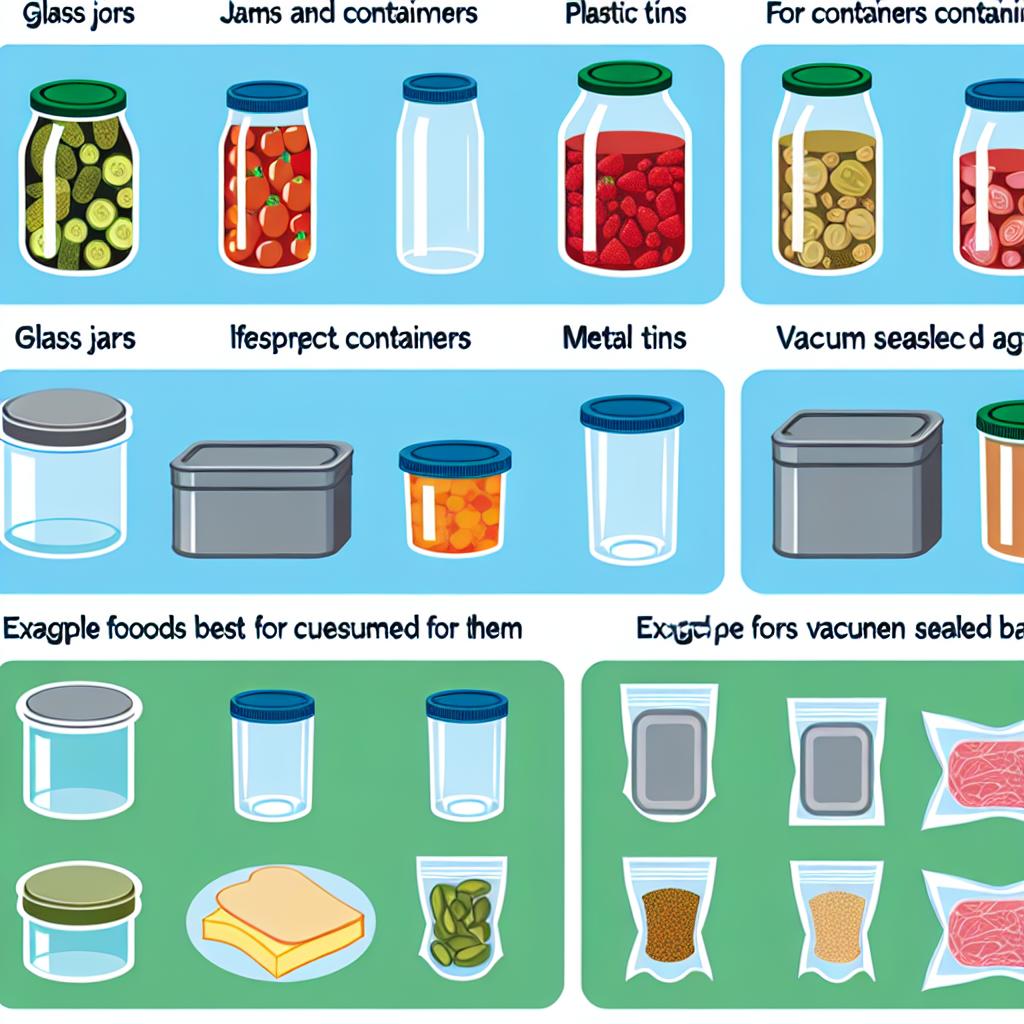Food storage is a crucial aspect of maintaining a well-stocked pantry and ensuring that your groceries last as long as possible. In this article, we will explore essential techniques for long-lasting food storage that can help you minimize waste and save money in the long run. From proper packaging to optimal storage conditions, these tips will help you extend the shelf life of your food items and keep your kitchen well-stocked for any occasion.
Table of Contents
- Essential Techniques for Long-Lasting Food Storage
- Choosing the Right Containers for Optimal Preservation
- Utilizing Proper Labeling and Organization Methods
- Implementing Vacuum Sealing for Extended Freshness
- Utilizing Temperature Control for Maximum Shelf Life
- Q&A
- In Summary
Essential Techniques for Long-Lasting Food Storage
When it comes to long-lasting food storage, there are several essential techniques that can help you preserve your food for extended periods of time. By following these techniques, you can ensure that your food stays fresh and safe to eat for as long as possible.
One important technique for long-lasting food storage is proper packaging. Make sure to use airtight containers or vacuum-sealed bags to prevent air and moisture from getting in and spoiling your food. Additionally, storing food in a cool, dark place can help extend its shelf life. Avoid storing food near heat sources or in direct sunlight, as this can cause it to spoil more quickly.
Another key technique for long-lasting food storage is rotation. Make sure to rotate your food supplies regularly, using older items before newer ones. This will help prevent food from expiring before you have a chance to use it. By following these essential techniques, you can ensure that your food stays fresh and safe for as long as possible.

Choosing the Right Containers for Optimal Preservation
When it comes to preserving food for long-lasting storage, choosing the right containers is essential. The type of container you use can make a significant difference in the shelf life and quality of your stored food. Here are some essential techniques to consider when selecting containers for optimal preservation:
- Airtight Seal: Look for containers that have airtight seals to prevent air and moisture from getting in, which can lead to spoilage.
- Material: Choose containers made from food-grade materials such as glass, stainless steel, or BPA-free plastic to ensure the safety of your stored food.
- Size: Select containers that are the right size for the amount of food you plan to store, as empty space can lead to faster spoilage.
By following these techniques and choosing the right containers, you can ensure that your food stays fresh and preserved for longer periods, saving you time and money in the long run.

Utilizing Proper Labeling and Organization Methods
Proper labeling and organization are key components of effective food storage. By utilizing these techniques, you can ensure that your food stays fresh for longer periods of time and that you can easily locate items when needed. One essential method is to label all containers with the date of purchase or expiration to help you keep track of when items need to be used or discarded.
Organizing your pantry or refrigerator with like items grouped together can also help streamline meal preparation and prevent food waste. Consider using clear containers or bins to store smaller items like spices or snacks, making it easier to see what you have on hand. Additionally, creating a designated space for each type of food can help prevent overcrowding and ensure that items are easily accessible.

Implementing Vacuum Sealing for Extended Freshness
When it comes to preserving the freshness of your food for an extended period, vacuum sealing is a game-changer. By removing the air from the packaging, vacuum sealing helps to prevent oxidation and slows down the growth of bacteria, mold, and yeast. This technique is especially useful for storing perishable items such as meat, fish, cheese, and vegetables.
One of the key benefits of vacuum sealing is that it can significantly extend the shelf life of your food. By creating an airtight seal, vacuum sealing helps to maintain the quality and flavor of your food for much longer than traditional storage methods. This can save you money in the long run by reducing food waste and allowing you to buy in bulk without worrying about spoilage.
Additionally, vacuum sealing is a great way to save space in your fridge or freezer. By removing the air from the packaging, vacuum-sealed bags and containers take up less room than traditional storage methods. This can help you maximize the storage capacity of your appliances and keep your kitchen organized and clutter-free.

Utilizing Temperature Control for Maximum Shelf Life
When it comes to maximizing the shelf life of your food, temperature control is key. By storing your food at the proper temperature, you can ensure that it stays fresh for longer periods of time. Here are some essential techniques for utilizing temperature control to extend the shelf life of your food:
- Refrigeration: Store perishable items such as dairy, meat, and produce in the refrigerator to slow down the growth of bacteria and extend their freshness.
- Freezing: Freeze items that you won’t be using immediately to preserve their quality. Make sure to package them properly to prevent freezer burn.
- Temperature Monitoring: Use a thermometer to regularly check the temperature of your refrigerator and freezer to ensure they are set at the optimal levels for food storage.
| Food Item | Optimal Storage Temperature |
|---|---|
| Milk | Below 40°F |
| Beef | Below 32°F |
| Leafy Greens | 32-40°F |
By following these techniques and paying close attention to temperature control, you can significantly increase the shelf life of your food and reduce waste. Proper storage practices will not only save you money but also ensure that your food stays safe to eat for longer periods of time.
Q&A
Q: Why is long-lasting food storage important?
A: Long-lasting food storage is important to ensure that you have access to nutritious food during emergencies or times when fresh food is not readily available.
Q: What are some essential techniques for long-lasting food storage?
A: Some essential techniques for long-lasting food storage include vacuum sealing, using airtight containers, freezing, canning, and dehydrating food.
Q: How can vacuum sealing help with long-lasting food storage?
A: Vacuum sealing removes air from the packaging, which helps prevent the growth of bacteria and mold, extending the shelf life of the food.
Q: What types of food are best suited for freezing?
A: Foods that are best suited for freezing include meats, fruits, vegetables, and baked goods. Proper packaging is key to maintaining the quality of frozen foods.
Q: How does canning help preserve food?
A: Canning involves heating food in jars to kill bacteria and seal the jars, creating a vacuum that prevents spoilage. This method is commonly used for preserving fruits, vegetables, and jams.
Q: What are the benefits of dehydrating food for long-lasting storage?
A: Dehydrating food removes moisture, which inhibits the growth of bacteria and mold. Dehydrated foods are lightweight, compact, and have a long shelf life.
Q: How can I ensure that my long-lasting food storage remains safe to eat?
A: To ensure the safety of your long-lasting food storage, regularly check for signs of spoilage, such as unusual odors, discoloration, or bulging packaging. Follow proper storage guidelines and rotate your stock to use older items first.
In Summary
In conclusion, mastering the essential techniques for long-lasting food storage is crucial for maintaining a well-stocked pantry and reducing food waste. By following the tips outlined in this article, you can ensure that your food stays fresh and safe for consumption for an extended period of time. Remember to rotate your stock, label your containers, and store food in appropriate conditions to maximize its shelf life. With a little planning and organization, you can enjoy the benefits of a well-preserved food supply for months to come. Happy storing!

